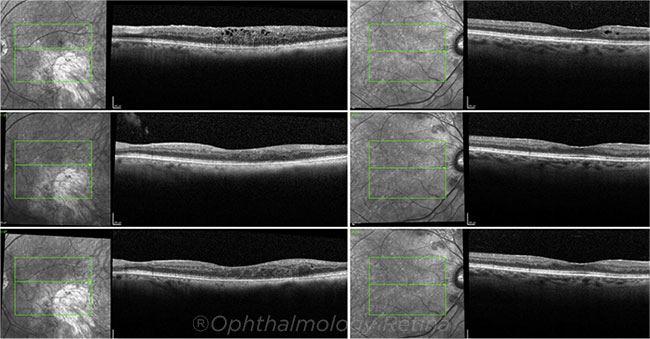Aflibercept Effective for Radiation Maculopathy
By Jean Shaw
Selected By: Andrew P. Schachat, MD
Journal Highlights
Ophthalmology Retina, July 2019
Download PDF
Murray et al. set out to evaluate whether intravitreal aflibercept could help maintain vision in patients who received radiation for uveal melanoma. They found that the anti-VEGF treatment appears to limit vision loss associated with radiation maculopathy.
For this prospective study, the researchers enrolled 40 patients with uveal melanoma and documented tumor control. All patients had visually compromising radiation maculopathy, which was documented by spectral-domain optical coherence tomography (SD-OCT) and confirmed by a decline in best-corrected visual acuity (BCVA).
 |
COMPARISON. A patient in the treat-and-extend arm (left) and the fixed-schedule arm (right), during the initial visit (top), the fifth visit (center), and the final visit (bottom). Adapted from Ophthalmology Retina.
|
The patients were randomly assigned to receive injections of aflibercept 2.0 mg/0.05 mL either on a fixed six-week schedule or under a treat-and-extend protocol. For those in the treat-and-extend arm, improvement in maculopathy, as seen on SD-OCT, allowed for a one-week increase in the follow-up interval; conversely, a worsening in maculopathy mandated a one-week decrease. Main outcome measures were BCVA and SD-OCT measurements of central retinal thickness.
Thirty-nine of the 40 patients completed the study with 60 weeks of follow-up. Mean BCVA at baseline was 20/63; this was maintained at 20/62 at the study’s conclusion. Mean SD-OCT central retinal thickness was 423 μm at baseline; this improved to 294 μm at 60 weeks.
Visual acuity improved by 3 or more lines in five patients, decreased by 3 or more lines in six patients, and held stable in the remainder. One patient experienced a single episode of an inflammatory response after receiving an intravitreal injection. No other adverse side effects were noted.
With regard to the two treatment approaches, the authors noted that they initially hoped that the treat-and-extend arm would allow for fewer intravitreal injections during the course of the study. However, this did not prove to be the case, as virtually all patients required treatment every six weeks.
The original article can be found here.